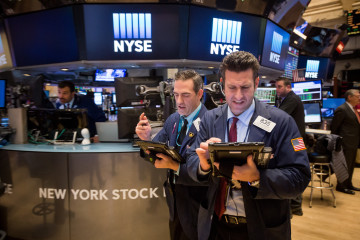Are You as Stupid as Your Financial Adviser Thinks?

published Aug 25th 2016, 5:00 am, by Ben Steverman
(Bloomberg) —
Investors need to be saved from themselves.
That’s the conventional wisdom, and there’s some truth to it. Individual investors can have comically bad timing. They buy when stock prices are high. They panic and sell when markets plunge. They invest with the hot mutual fund managers just as the managers’ luck runs out.
And what’s their reward? They supposedly underperform the very mutual funds they invest in by some four percentage points a year, or more, according to an annual study by the research firm Dalbar.
If we’re acting that foolishly, clearly we should be handing our money over to professional financial advisers. Even if the pros charge us 1 percent or more a year in fees, we’ll come out ahead, right?
Independent experts aren’t sold
Look at the sheer amount of investor bungling that Dalbar calculates each year in its Quantitative Analysis of Investor Behavior, or QAIB. Last year, the report said, the average equity mutual fund investor underperformed the S&P 500 index by 3.7 percentage points. Over the past 30 years, the QAIB finds, stock fund investors lagged behind the market by an average of 6.7 points a year.
To some, those numbers seem way too high. “The Dalbar analysis has a kernel of truth but almost certainly overstates the bad market timing of individual investors,” says Brad Barber, a finance professor at the University of California at Davis. A recent article by mathematician Michael Edesess argues that Dalbar’s conclusions can’t be used to demonstrate the folly of individual investors. Yet, he says, financial advisers routinely use it to justify high fees.
“This is not science and it is not logic,” Edesess wrote last month. “It is hasty interpretation of mathematical and empirical results in order to feed the need for marketing arguments or talking points.”
Clients do need help, says Edward Gjertsen II, the chairman of the Financial Planning Association, but they should choose their financial adviser carefully. Make sure the adviser is a fiduciary—legally required to put your interests first—and seek out advisers and planners who aren’t just good at selling investments. They should help you set broader financial goals and decide between such priorities as buying real estate and paying down debt.
There are two ways to calculate investment returns. There are the performance figures that a mutual fund posts in any period. That’s the fund’s total return minus its expenses. Then there’s the performance that the investors in that fund actually experience over time. This can be calculated by looking at the money they put into the fund and take out of it on a daily, weekly, or monthly basis.
Inevitably there’s going to be a gap between the two, because it’s rare for an investor to put money in a fund and never touch it again. Workers are constantly putting more money in their 401(k)s, while retirees spend down their investments.
Investment research firms such as Dalbar and the giant Morningstar look at these flows and conclude that investors are hurting themselves with bad timing. Edesess argues that the gap they identify could have just as much to do with factors outside of investors’ control—such as what’s happening in the market or when people have the money to invest.
A young worker who started a job and a 401(k) in the past several years will look as though she had spectacular timing, because markets have surged since 2009. But what about an older worker who started investing with a generous 401(k) in the early 2000s and in 2007 lost that job shortly before the recession hit? He’ll look as if he had terrible timing, because market returns were so mediocre in the early 2000s and he missed out on buying stocks at the 2008-09 lows.
“The upshot,” Edesess says, is “we do not really know that the typical or average investor underperforms because of bad market timing.”
And it’s impossible to check Dalbar’s math, because the firm won’t share its formula.
“As soon as that formula hits the public domain, its value evaporates,” says Dalbar’s president and chief executive officer, Louis Harvey.
Harvey says the QAIB makes sophisticated estimates designed to capture “the difference between what a fund pays out in return and what an investor perceives it to be.” The result is a “net effect” of all investor behavior, he says, “recognizing full well that it’s a very simplified view of what’s going on in the market.”
Huh? say some researchers. “I have been genuinely puzzled about their calculation, because it just does not make sense to me, at least from what they sent to me when requested,” says Emory University accounting professor Ilia Dichev.
Morningstar does a similar analysis but is much more transparent about its methodology and finds a much narrower gap between what investments reportedly earn and the return investors actually receive. Its 2016 “Mind the Gap” report finds that over the past 10 years, “investors cost themselves from 0.74 percent to as much as 1.32 percent per year by mistiming their purchases and sales.” That’s about a third of the gap that Dalbar finds over the same time period.
Both Dalbar’s and Morningstar’s reports are used to suggest that individuals are too emotional and impulsive to manage investments on their own. Dalbar’s Harvey says this is largely the right conclusion to draw.
“It is fairly clear that investors can use help in their investment decisions—whether that help comes from an adviser, a robo-adviser, or a parent, or friend,” he says.
Morningstar’s Russel Kinnel observes that in 2009, while stocks were hitting their lowest prices in a decade, investors pulled $16 billion from U.S. stock funds and put $291 billion into bond funds. “There is a large body of research demonstrating that individual investors make poor market-timing decisions,” he says.
Academic research does suggest investors have poor timing. Studies show they underperform their investments by one to one-and-a-half percentage points a year, Emory’s Dichev says.
But it’s not clear that individual investors are any worse at timing than the pros. Hedge funds, mutual fund managers, and institutional investors all have trouble.
Well-paid hedge fund managers have lagged the market in recent years. Dichev and Harvard University professor Gwen Yu found in a 2011 study that investors in those hedge funds, who tend to be large, sophisticated institutions or wealthy individuals, experienced actual returns that were three to seven percentage points lower than the official fund returns.
“ ‘Bad’ timing is strongly built into the system, and personal advisers are probably prone to it as well,” Dichev says.
Financial advisers can even make their clients perform worse, if they charge high fees or move money around to maximize commissions. “Hiring an adviser is probably the worst mistake they can make, if it’s an expensive adviser,” Edesess says.”People should be seeking more than just investment advice. They should be seeking financial advice,” says Gjertsen, of the Financial Planning Association, who is vice president at Mack Investment Securities in Glenview, Ill.
Even if researchers can’t agree on the size or the causes of the gap, it’s real. And whether you work with an adviser or invest on your own, there’s only one way to close it: Buy and hold on for the ride, while keeping fees as low as possible.
To contact the author of this story: Ben Steverman in New York at bsteverman@bloomberg.net To contact the editor responsible for this story: Peter Jeffrey at pjeffrey@bloomberg.net
copyright
© 2016 Bloomberg L.P
niCodes




No Comment